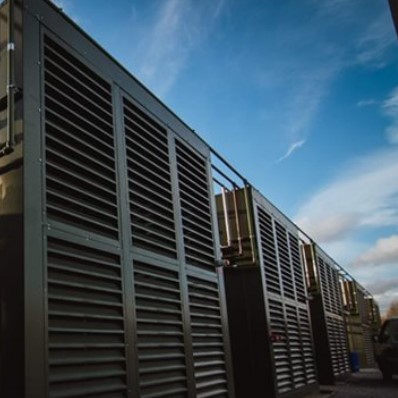Infinis is one of the UK’s leading generators of renewable power. Its total installed capacity of 571 MW is generated at 143 sites, including 123 landfill gas plants, 10 onshore wind farms and 10 hydroelectric plants.
The company’s headquarters are in Northampton, and it employs approximately 400 people, of whom around 190 are engineers. Many of Infinis’ sites are located in remote areas and most of its generators run without any need for human oversight or intervention.
Because most of the sites are unmanned, the company relies on a sophisticated network of IT systems to enable remote management and report any problems.
Sophisticated sensors and alarms
The company’s generators are fitted with a comprehensive range of sensors that monitor the condition of each component and can generate alarms when predefined thresholds are reached.
These alarms are managed by SCADA and BMS systems that relay data to the company’s logistics centre in Northampton.
Our client explained the rationale behind the project:
“The infrastructure we’re managing is very complex, and in the case of our landfill gas generators, it requires a relatively high level of reactive maintenance. By its nature,
landfill gas is a variable-quality fuel, and processing it takes a toll on our equipment.
To ensure the safe operation of these sites and maintain a steady supply of electricity to the National Grid, we need to react quickly when a generator goes offline. On the other hand, sending engineers out to these sites at short notice is a time-consuming and expensive business.
If we can use our IT systems to shift the emphasis away from reactive maintenance and towards planned maintenance, we’ll be able to deliver a better level of service while reducing our operational costs.”
Neil Douglas, Head of IT,
Infinis


Our client explained the rationale behind the project:
“Until recently, the team at the logistics centre had to use four different systems to coordinate our response to an alarm.
With up to 1,000 calls coming in from field engineers each day, and 2,000 work orders being generated per week, it was becoming very difficult to keep up with the workload.
There was very little continuity between systems, so data had to be re-keyed manually, and different operators had different ways of handling things, so it was hard to maintain a consistent approach.”
“We had been using Maximo® for asset management and maintenance for about six years, and we had also extended it to handle procurement and inventory management.
We were very confident in the IBM platform as a basis for managing our core operational processes, so it was a logical step to use it as the foundation for the IMS too.
By combining our in-house telemetry skills with Peacock Engineering’s expertise in IBM Maximo, we have been able to create a system that genuinely transforms the way we handle incidents at our sites.”
An expert partnership
Working with Peacock Engineering, an IBM Gold Business Partner that specialises in service and asset management consultancy projects.
Infinis decided to integrate the SCADA and BMS alarms into its IBM® Maximo® Asset Management asset management system, creating a comprehensive incident management system (IMS).
Integrating alarm systems with asset management
The integration of SCADA with asset management systems may be on the wish-list for many companies in the energy and utilities sector, but Infinis is one of the first to have implemented it successfully.
When alarms are triggered at one of the company’s sites, the SCADA and BMS systems send the relevant data to the IMS, which links each alarm to the appropriate asset.
The system also displays all the open work orders that may affect that asset, as well as confirming whether the generator is authorised for a remote restart, or whether it
must be restarted manually.
If necessary, it also creates a work order and allocates it to an engineer via the Click Maximo® Integration Gateway – a solution developed by Peacock Engineering that gives Maximo® access to the advanced job scheduling capabilities of Click Schedule software.


“Bringing all the information together in a single place helps us be much more intelligent about reactive maintenance. We can see all the alarms that have been triggered on a single asset, as well as the maintenance history of each component and any work that is currently due to take place.
This gives us a much better ability to diagnose the problem, which means we can send an engineer with the right skills and the right spare parts to deal with it quickly and effectively.
Ultimately this means faster repairs, fewer wasted journeys, and greater efficiency”
Neil Douglas, Head of IT,
Infinis
Better operational management of incidents
Engineers have also commented that having the alarm information linked to the work order greatly improves their ability to diagnose faults accurately and quickly.
Historically, alarms would have been cleared from the system long before the engineer got to the site, making effective root-cause analysis difficult.
Feedback from users in the logistics centre has been extremely positive: the vast majority testify that they can work more efficiently and react more quickly when an incident arises.
Moving towards predictive maintenance
In addition to the improvements in day-to-day operations, the IMS provides deeper insight into the causes and frequencies of different types of incident.
This helps Infinis organise its planned maintenance cycles in a more effective way. Evidence that Infinis is succeeding in these efforts is provided by improvements in a number of the company’s key performance indicators.
For example, mean time between breakdowns has increased and mean time to repair has fallen since the IMS was launched.
What the client said:
“The ability to predict where failures are most likely to occur ultimately leads to fewer outages, less emergency maintenance work, and greater total production across our generation infrastructure.
This means we can ensure a safe, efficient and reliable supply of electricity to the National Grid while keeping our costs as low as possible.”
Neil Douglas, Head of IT,
Infinis
Infinis’ Incident Management System
Instrumented: SCADA and BMS systems at Infinis’ power plants across the country send alarm data to a central, Maximo-based incident management system (IMS) at the company’s main logistics centre.
Interconnected: In an end-to-end process, the alarm data is used to create incident records and trigger the creation of maintenance work orders, which are then assigned to skilled engineers for resolution.
Intelligent: Combining alarm data with incident reports and work orders provides a 360-degree view of asset maintenance, enabling more accurate analysis of root causes and more effective maintenance planning.
Business benefits
- Provides new insight into the root causes of breakdowns, enabling a more predictive approach to planned maintenance
- Contributes to an improvement in mean time between breakdowns and a reduction in mean time to repair
- Boosts the total availability of generators, helping to provide a more reliable supply and comply with service level agreements
- Centralises 90 percent of operational management in single system, making it easier for staff to manage more than 500 incidents and 2,000 work orders per week

Get started with a better EAM solution – contact our experts today
Call us on +44(0)20 3356 9629 or use our contact form below.Contact us now





